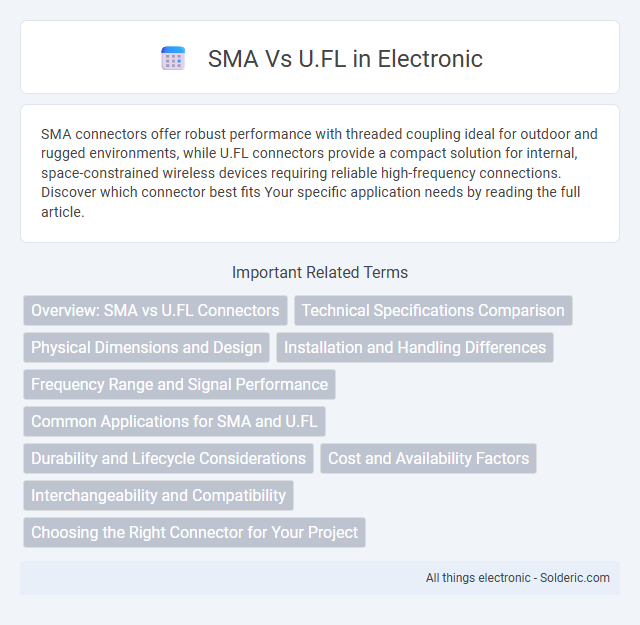SMA connectors offer robust performance with threaded coupling ideal for outdoor and rugged environments, while U.FL connectors provide a compact solution for internal, space-constrained wireless devices requiring reliable high-frequency connections. Discover which connector best fits Your specific application needs by reading the full article.
Comparison Table
| Feature | SMA Connector | U.FL Connector |
|---|---|---|
| Connector Type | Threaded RF coaxial | Snap-on, micro coaxial |
| Size | ~8mm diameter | 2mm diameter |
| Frequency Range | DC to 18 GHz | DC to 6 GHz |
| Insertion Loss | Low (typically < 0.15 dB at 2.4 GHz) | Low but higher than SMA (~0.3 dB at 2.4 GHz) |
| Durability | High, supports 500+ mating cycles | Lower, supports ~30 cycles |
| Applications | WiFi, Cellular, RF test equipment, antennas | Embedded wireless modules, internal PCB antenna connection |
| Cost | Higher | Lower |
| Installation | Requires tools for tightening | Tool-free, snap-on |
Overview: SMA vs U.FL Connectors
SMA connectors feature threaded coupling for secure RF connections, widely used in applications requiring durability and high-frequency performance up to 18 GHz. U.FL connectors, ultraminiature and snap-on style, are ideal for internal connections in compact devices like laptops and smartphones, supporting frequencies up to 6 GHz. SMA connectors offer superior mechanical robustness, while U.FL connectors prioritize space-saving design for dense electronic assemblies.
Technical Specifications Comparison
SMA connectors typically offer a threaded interface with a frequency range up to 18 GHz and impedance of 50 ohms, making them ideal for high-frequency RF applications requiring durability. U.FL connectors are micro-miniature, designed for frequencies up to 6 GHz with a 50-ohm impedance, suited for compact devices where space saving is critical. The SMA's robust construction supports higher power handling and mechanical stability, whereas U.FL connectors prioritize miniaturization and ease of assembly in tight spaces.
Physical Dimensions and Design
SMA connectors feature a robust, threaded design with a diameter of approximately 8 mm, offering secure and stable connections ideal for outdoor or high-vibration environments. U.FL connectors are significantly smaller, measuring about 2 mm in diameter, designed for compact, internal device use where space is highly constrained. Your choice between SMA and U.FL will depend on the available physical space and the need for mechanical durability in your application.
Installation and Handling Differences
SMA connectors feature threaded coupling, providing a secure and vibration-resistant connection ideal for stable environments, but require precise torque during installation to avoid damage. U.FL connectors use a snap-on mechanism designed for compact, space-limited applications and are easier to install by hand, yet they are more delicate and prone to damage if handled improperly. Your choice depends on whether durability and ruggedness (SMA) or miniaturization and quick assembly (U.FL) are priorities in your project.
Frequency Range and Signal Performance
SMA connectors support a frequency range up to 18 GHz, offering excellent signal integrity and low loss ideal for high-frequency RF applications. U.FL connectors operate up to 6 GHz, suited for compact devices requiring reliable performance at moderate frequencies. SMA connectors provide superior signal performance in demanding environments, while U.FL balances size and functionality for embedded systems.
Common Applications for SMA and U.FL
SMA connectors are commonly used in applications requiring durable, weather-resistant connections such as outdoor antennas, cellular networks, and Wi-Fi devices. U.FL connectors are ideal for internal laptop antennas, GPS modules, and compact IoT devices due to their small size and ease of integration on printed circuit boards. Choosing between SMA and U.FL depends on your device's size constraints and environmental exposure requirements.
Durability and Lifecycle Considerations
SMA connectors offer superior durability with a robust metal construction designed for frequent mating cycles, typically supporting over 500 connection and disconnection cycles. U.FL connectors, while compact and ideal for space-constrained applications, have a lower lifecycle, usually rated for around 30 mating cycles, making them less suitable for frequent reuse. Your choice between SMA and U.FL should consider the expected connector usage frequency and mechanical stress to ensure optimal longevity and performance.
Cost and Availability Factors
SMA connectors generally have higher costs due to their robust construction and superior performance in high-frequency applications, making them less available for budget-conscious projects. U.FL connectors offer a more affordable option with widespread availability in compact devices, ideal for internal antenna connections where cost efficiency is crucial. Your choice depends on balancing budget constraints with performance needs, as SMA connectors are pricier but easier to find in specialized markets compared to the ubiquitous and cost-effective U.FL connectors.
Interchangeability and Compatibility
SMA and U.FL connectors are not interchangeable due to their distinct sizes and design specifications, with SMA being larger and typically used for outdoor or higher-power applications while U.FL is compact and suited for internal, low-power connections. Compatibility depends on the device and cable requirements, where SMA is common for robust RF connections in antennas and U.FL fits tightly within circuit boards for space-saving needs. Your choice between SMA and U.FL should consider both physical compatibility and the intended RF performance criteria.
Choosing the Right Connector for Your Project
Selecting between SMA and U.FL connectors depends on your project's size, frequency range, and durability needs. SMA connectors offer robust performance with superior durability and operate reliably up to 18 GHz, ideal for outdoor or high-power applications. U.FL connectors are compact and lightweight, suitable for space-constrained devices with frequencies up to 6 GHz, making them perfect for internal PCB connections in portable electronics.
SMA vs U.FL Infographic

 solderic.com
solderic.com